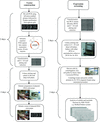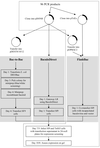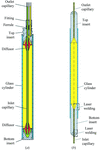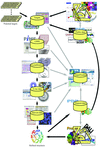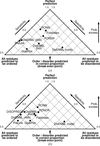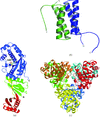issue contents
October 2006 issue
Structural Proteomics IN Europe

Cover illustration: A montage of 238 representative protein crystal and NMR structures (of a total of 308) determined as part of the SPINE project, using high-throughput technologies developed and implemented in SPINE laboratories.
research papers
Open  access
access
 access
accessThe technology output from the Structural Proteomics In Europe (SPINE) consortium for cloning and expression in E. coli is reviewed.
Open  access
access
 access
accessStrategies and experience resulting from the use of eukaryotic expression systems in SPINE are described.
Open  access
access
 access
accessCharacteristics such as the purity of target proteins are key factors that can influence the success of structure determination. Here, the application and efficacy of various quality-assessment methodologies are discussed.
Open  access
access
 access
accessThe introduction of automation and minimization into the crystallization pipeline has improved the yield of high-quality crystals for structural determination using more reproducible experimental protocols.
Open  access
access
 access
accessNew hardware and software developments for protein structure determination by NMR are described. These techniques allow faster, more automated solution-structure determination and more efficient data utilization.
Open  access
access
 access
accessAutomated data collection for macromolecular crystallography at beamlines with protocols for automatic instrumentation improves the efficient use of available beamtime. These developments were a result of a collaboration between the main partners of SPINE and members of other similar European and national initiatives.
Open  access
access
 access
accessThe results of a workshop on the automation of protein crystal structure solution organized by the Structural Proteomics In Europe (SPINE) consortium are reported.
Open  access
access
 access
accessThis article reviews the infrastructure of software that has been developed under the SPINE initiative for high-throughput protein-structure analysis covering target selection and prototype LIMS for protein production through to structure annotation, with contributions to the management of a large-scale crystallization set-up and structure determination.
Open  access
access
 access
accessProgress by the SPINE consortium on the determination of structures of proteins of bacterial and viral pathogens is outlined, with particular reference to the impact of high-throughput technologies.
Open  access
access
 access
accessProgress in the determination of structures of human proteins by the Structural Proteomics In Europe (SPINE) consortium is outlined with highlights indicating the impact of high-throughput technologies.
Open  access
access
 access
accessThis article presents a comparative analysis of the standard methods for small-scale screening of recombinant protein expression/solubility implemented in laboratories of the Structural Proteomics In Europe (SPINE) consortium.
Open  access
access
 access
accessA multifermentation system, GRETA, has been developed which specifically accommodates features that respond to the needs of future structural genomics programmes. The GRETA multifermenter provides a robust platform for streamlined parallel fermentation, requiring minimal manual intervention, while at the same time providing a versatile fermentation platform for process optimization.
Open  access
access
 access
accessThe design of a new system for multi-expression in E. coli and a database for co-expression data are described. Lessons are drawn from case studies using these and other strategies for co-expression and analysis of protein complexes.
Open  access
access
 access
accessA simple, fast and affordable method for transient protein expression in mammalian cells is presented. It combines several features of interest for X-ray crystallography such as high protein yield, straightforward purification, selenomethinonine incorporation and control of N-linked glycosylation.
Open  access
access
 access
accessA sample holder standard for use with robotic sample changers is defined. The standard includes a system for sample identification, tracking and management of data flow in a macromolecular structure-determination pipeline. A robotic sample changer designed for use with the sample standard is described.
Open  access
access
 access
accessThe current state of methods for the in silico prediction of natively disordered regions of proteins is discussed in the context of the potential for improvement and application of these predictions in structural proteomics.
Open  access
access
 access
accessThe current state of high-throughput technologies for protein production and structure determination is assessed in relation to progress on the SPINE structural proteomics project on proteins from B. anthracis.
Open  access
access
 access
accessFor a structural genomics project on Epstein–Barr virus, 23 proteins were cloned into E. coli for protein expression. The structures of four have been solved by X-ray crystallography.


 journal menu
journal menu









